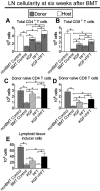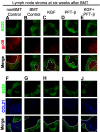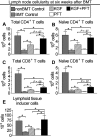Short-term inhibition of p53 combined with keratinocyte growth factor improves thymic epithelial cell recovery and enhances T-cell reconstitution after murine bone marrow transplantation
- PMID: 19965631
- PMCID: PMC2817635
- DOI: 10.1182/blood-2009-05-223198
Short-term inhibition of p53 combined with keratinocyte growth factor improves thymic epithelial cell recovery and enhances T-cell reconstitution after murine bone marrow transplantation
Abstract
Myeloablative conditioning before bone marrow transplantation (BMT) results in thymic epithelial cell (TEC) injury, T-cell immune deficiency, and susceptibility to opportunistic infections. Conditioning regimen-induced TEC damage directly contributes to slow thymopoietic recovery after BMT. Keratinocyte growth factor (KGF) is a TEC mitogen that stimulates proliferation and, when given before conditioning, reduces TEC injury. Some TEC subsets are refractory to KGF and functional T-cell responses are not fully restored in KGF-treated BM transplant recipients. Therefore, we investigated whether the addition of a pharmacologic inhibitor, PFT-beta, to transiently inhibit p53 during radiotherapy could spare TECs from radiation-induced damage in congenic and allogeneic BMTs. Combined before BMT KGF + PFT-beta administration additively restored numbers of cortical and medullary TECs and improved thymic function after BMT, resulting in higher numbers of donor-derived, naive peripheral CD4(+) and CD8(+) T cells. Radiation conditioning caused a loss of T-cell zone fibroblastic reticular cells (FRCs) and CCL21 expression in lymphoid stroma. KGF + PFT-beta treatment restored both FRC and CCL21 expression, findings that correlated with improved T-cell reconstitution and an enhanced immune response against Listeria monocytogenes infection. Thus, transient p53 inhibition combined with KGF represents a novel and potentially translatable approach to promote rapid and durable thymic and peripheral T-cell recovery after BMT.
Figures







Similar articles
-
Keratinocyte growth factor and androgen blockade work in concert to protect against conditioning regimen-induced thymic epithelial damage and enhance T-cell reconstitution after murine bone marrow transplantation.Blood. 2008 Jun 15;111(12):5734-44. doi: 10.1182/blood-2008-01-136531. Epub 2008 Mar 11. Blood. 2008. PMID: 18334670 Free PMC article.
-
Protection from thymic epithelial cell injury by keratinocyte growth factor: a new approach to improve thymic and peripheral T-cell reconstitution after bone marrow transplantation.Blood. 2002 Jun 15;99(12):4592-600. doi: 10.1182/blood.v99.12.4592. Blood. 2002. PMID: 12036893
-
Keratinocyte growth factor enhances DNA plasmid tumor vaccine responses after murine allogeneic bone marrow transplantation.Blood. 2009 Feb 12;113(7):1574-80. doi: 10.1182/blood-2008-05-155697. Epub 2008 Nov 14. Blood. 2009. PMID: 19011222 Free PMC article.
-
Thymic commitment of regulatory T cells is a pathway of TCR-dependent selection that isolates repertoires undergoing positive or negative selection.Curr Top Microbiol Immunol. 2005;293:43-71. doi: 10.1007/3-540-27702-1_3. Curr Top Microbiol Immunol. 2005. PMID: 15981475 Review.
-
The role of the thymus in allogeneic hematopoietic stem cell transplantation.Swiss Med Wkly. 2010 Jul 20;140:w13051. doi: 10.4414/smw.2010.13051. eCollection 2010. Swiss Med Wkly. 2010. PMID: 20648397 Review.
Cited by
-
Thymic Engraftment by in vitro-Derived Progenitor T Cells in Young and Aged Mice.Front Immunol. 2020 Aug 18;11:1850. doi: 10.3389/fimmu.2020.01850. eCollection 2020. Front Immunol. 2020. PMID: 32973763 Free PMC article. Review.
-
TP53 inhibitor PFTα increases the sensitivity of arsenic trioxide in TP53 wildtype tumor cells.FEBS Open Bio. 2022 Mar;12(3):616-626. doi: 10.1002/2211-5463.13366. Epub 2022 Jan 26. FEBS Open Bio. 2022. PMID: 35030298 Free PMC article.
-
Thymic T-cell development in allogeneic stem cell transplantation.Blood. 2011 Jun 23;117(25):6768-76. doi: 10.1182/blood-2011-02-334623. Epub 2011 Mar 22. Blood. 2011. PMID: 21427289 Free PMC article. Review.
-
A novel approach to improve immune effector responses post transplant by restoration of CCL21 expression.PLoS One. 2018 Apr 4;13(4):e0193461. doi: 10.1371/journal.pone.0193461. eCollection 2018. PLoS One. 2018. PMID: 29617362 Free PMC article.
-
Calcium/calmodulin-dependent kinase kinase 2 regulates hematopoietic stem and progenitor cell regeneration.Cell Death Dis. 2017 Oct 5;8(10):e3076. doi: 10.1038/cddis.2017.474. Cell Death Dis. 2017. PMID: 28981105 Free PMC article.
References
-
- Markova M, Barker JN, Miller JS, et al. Fludarabine vs cladribine plus busulfan and low-dose TBI as reduced intensity conditioning for allogeneic hematopoietic stem cell transplantation: a prospective randomized trial. Bone Marrow Transplant. 2007;39(4):193–199. - PubMed
-
- Weinberg K, Blazar BR, Wagner JE, et al. Factors affecting thymic function after allogeneic hematopoietic stem cell transplantation. Blood. 2001;97(5):1458–1466. - PubMed
-
- Douek DC, Vescio RA, Betts MR, et al. Assessment of thymic output in adults after haematopoietic stem-cell transplantation and prediction of T-cell reconstitution. Lancet. 2000;355(9218):1875–1881. - PubMed
Publication types
MeSH terms
Substances
Grants and funding
LinkOut - more resources
Full Text Sources
Other Literature Sources
Medical
Research Materials
Miscellaneous

